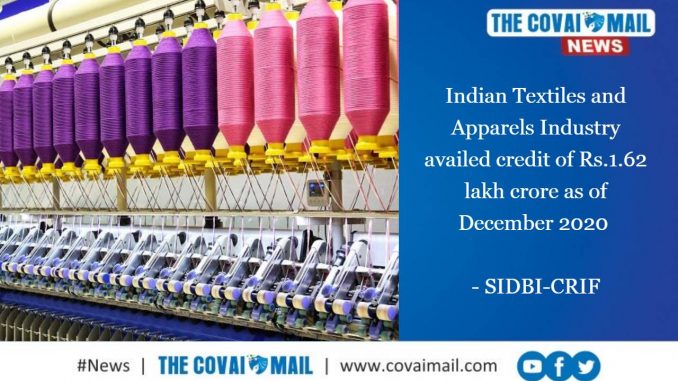
Small Industries Development Bank of India (SIDBI), the principal financial institution engaged in the promotion, financing and development of Micro, Small & Medium Enterprises (MSMEs), and CRIF High Mark, a leading Indian credit bureau launched on Tuesday its third edition of Industry Spotlight that analyses the ‘Indian Textile and Apparels’ industry.

Credit landscape in the Indian textile and apparels industry
According to the report, the total amount of credit availed by the sector as of December 2020 stood at Rs.1.62 lakh crore, which witnessed a Y-o-Y decline of nearly 20%. This is due to the suspension of manufacturing activities in the immediate aftermath of the COVID-19 lockdown in March 2020. The report also states that the number of active loans (volume), in the sector stood at 4.26 lakh, as of December 2020.
The industry observed a quarterly decline in Non-Performing Assets or NPAs (proportion of credit value delinquent by 90+ days) over the last 2 years, from 29.59% in September 2018 to 15.98% in September 2020. NPAs in December 2020 increased by 0.94% which is nearly 8% lower than NPAs in December 2019.
Export earnings from the sector dropped as of December 2020
Over the years, apparels have contributed to a majority share of exports, followed by home textiles and fabric. However, as per the third edition of the Industry Spotlight, export credit as of December 2020 stands 25% lower Y-o-Y, largely attributable to a decline in exports due to the pandemic.
MSME borrowers have a lion share of the overall credit by volume
With 95% of the overall credit by volume of the sector concentrated in micro, small and medium segment of borrowers, the industry has a presence of close to 5 lakh borrowers as of December 2020.
Geographical insights on top textile hubs
At the state level, Maharashtra has the largest share of the credit portfolio at 25% of the credit book to the sector.
The report emphasizes that the top thirteen regions rich in textiles and apparels manufacturing accounted for 80% of the credit portfolio of the sector as of December 2020. Nearly all states have districts manufacturing textiles and apparels, having several credit active units. Some districts such as Mumbai and Surat have more than Rs. 10,000 crore credit portfolios as of December 2020.
